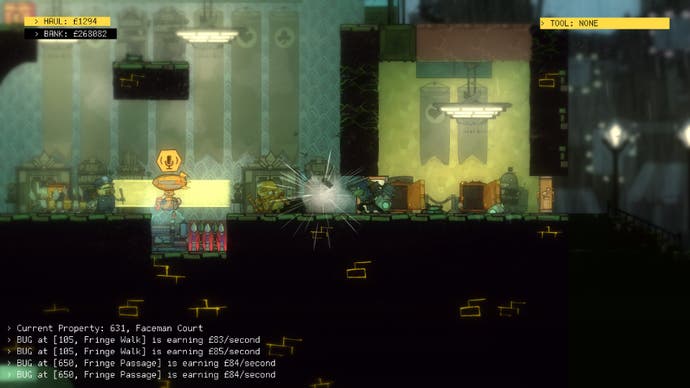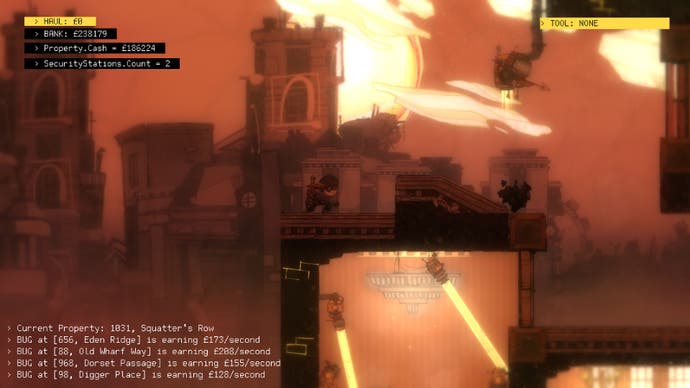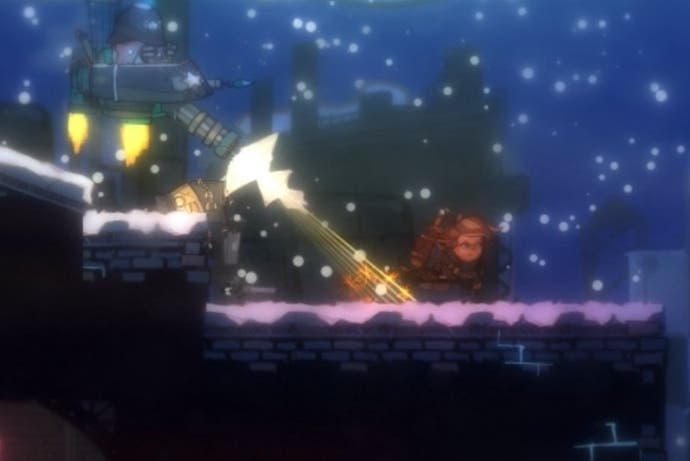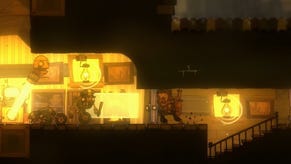The Swindle review
Burglar King.
It is fascinating to think about the numbers that developers choose to work with, and 100 - a plain old century - is the most intriguing number that has come my way in quite a while. The Swindle gives you 100 days to prepare for its final mission, and while that's enough time to allow you to work around unforeseen accidents, it's also enough time to ensure that failure will really sting. On my first attempt, those 100 days of build-up culminated in a mission that lasted 12 seconds start to finish, and ended, as all unsuccessful missions do, with a blizzard of banknotes and the crumpled thunk of a sodden body impacting on the cobblestones.
The Swindle's a knockabout 2D platformer at heart: a Spelunky-flavoured, steampunky muddle of stealth and violence in which you rob a series of procedurally scrambled mansions. Who doesn't like a good caper? But when this game swipes at you with its claws, it can draw blood, and that 100-day time limit is the reason. You will really love this, or you will really hate it, I suspect. I really love it.
We're in Alternate Victorian London here, surrounded by clanking robots and rattling blimps. The world is viewed through a thick smudge of dirt and smoke, and technology, by and large, tends to look like it might be an early form of Teasmaid. In 100 days, Scotland Yard will turn on The Devil's Basilisk, a mass surveillance system that will basically end all crime for good. Cast as a criminal - or rather a whole motley of them - you have a certain vested interest in this not happening, so you hatch a plan to swipe the bobbies' nasty machine before it's been activated. Kitting out for that final mission is going to cost you money, though, which means 100 days of increasingly risky robberies as you spend your way through the necessary upgrade trees. Voila: a pleasant sense of escalation and a comment on government surveillance. Its mere existence fundamentally alters the behaviour of the population it is spying on - and not in a good way.
Welcome to 1126 Assembly Avenue, where a crime is being committed. Several, in fact, if you consider the lack of elegance in the committing of a crime to be something of a crime in itself. Dewdrop Billy (tentative catchphrase: "I dew drop in, and then I hit you with a billy") is on the scene. He has broken windows and he has plundered safes. He has clubbed patrolling robot guards into tidy piles of cogs and springs, and he has shattered floating machine-guns with a deft swipe of the truncheon. Sadly, he has also tripped the alarm and the cops are coming. Sadder still, he has just entered a room through a hole in the ceiling only to find himself confronted with a dead end - and, of course, a hole in the ceiling he can no longer reach. Dewdrop Billy failed to buy double-jump before he set off on his most recent caper, just as he failed to buy bombs, or the ability to remotely detonate mines. His most recent caper is likely to be his last.

The crucial thing about this story is not that The Swindle will drop you into levels that you can't easily get out of, although it definitely will. It's that it gets to the crux of the game, which is all about trying to prepare yourself for something terrifying, while fending off the dark specter of temptation. The Swindle generates unbeatable levels because it gives you the tools to beat any level. The question becomes: in what order do you acquire these tools? And how many will be enough to allow you to try for the really big job that's forever leering on the horizon?
There is a wonderful relationship here between the scaling horrors of the houses you are sent to burgle and the scaling wonder of the gadgets and abilities you can use to do so. Each of your 100 days represents one robbery - you lose any cash you have in hand if killed, but keep the haul in your bank account and any upgrades, which are passed on to your next procedurally generated thief - and you'll start off in the slums, facing the flimsiest of patrolling robots and other security measures as you get to grips with the weak opening jump, the wall-scramble for climbing, and the wall-slide for descending (careful with this last one, as you never know what's lurking beneath you).
This is stealthy territory, which means you mark time by the number of silent takedowns behind you, but there are plenty of other milestones. Early on, you'll unlock the ability to hack computers for a big cash payout, and you'll also learn to avoid the clearly-displayed vision areas of each enemy you encounter as, once the alarm's tripped, cash starts to disappear and the police arrive, overpowered to start with, and increasingly godlike as the clock ticks on.

With the money you earn, you can unlock new areas that see you working your way upwards through the teetering hierarchy of London, from warehouses and semi-fancy townhouses to casinos and massive banks where the louring sky is stained sodium orange or blood red. Top-tier security includes walking gramophones who fire mechanical hornets at you in bronzed swarms, or a rotating cube that chugs across the ground towards you and attacks with surprising bursts of speed. The art style, which is hand-drawn and intricate - and is animated in a manner that puts me in mind of Noggin the Nog, the ancient and terrifying children's show that utilised cardboard cut-outs manipulated in real-time by magnets - is perfect for lending haphazard, addled character to an endless army of unlikely machines. One of the great joys of the game is learning the dangers and the weak spots of each baddy you come across: which kind of enemy can see you from miles off, for example, and which can be subdued by a single swipe from behind.
Some foes, such as an explosive mini-blimp that will hear your footsteps through walls, can actually be useful, as they can be lured toward spots that you'd quite like to blast to pieces in the first place. Or you could just use a bomb, or the teleport move. As in Spelunky, there is a rich ecology here that clips together in very interesting ways, and at 15 hours in, I'm still being surprised by stuff that happens. I've just discovered that the wandering robots which seem to have a human brain clamped to the tops of their torsos can open doors. Equally, I've just equipped EMP blast for the first time, and now I never want to leave my airship hub without it.
Speaking of those doors: while I'm not sure that the upgrade shop has much scope to offer a range of fundamentally different character builds to work towards, it does offer enough diversity to lure you away from a definitive racing line - at least now, before the Wikis ramp up. Relatively early on in the game, you'll move from buildings where the front door is pretty much wide open to buildings where it's locked, and you can pay for a skill that will allow you to hack through the lock. Or you could ignore that, assuming that a little scampering will give you a window to enter through somewhere higher up. But what if there's no window? You've just blown an entire day.
I've made it to the final mission without the door hack, in other words. But I've never made it to the final mission without bugs (not game bugs). Bugs are potentially a balancing problem with The Swindle, but the more I play, the less of an issue they seem to be. These handy little doodads are a relatively expensive upgrade that gives you a second option whenever you find a computer. Normally, you would hack these for a one-time cash hit. As the game develops though, you can bug them, and that allows you to collect a smaller payment but one that repeats every second, even once you've left the level and moved on to your next job.
Criminologists amongst you will notice a shift in the very nature of the crime being committed here, from burglary, which is thrilling and risky and takes place at the sharp end, to computer fraud, which is passive and slightly dull and operates at a distance. There is a reason that computer fraudsters tend to be rather overweight and drab: once I discovered bugs, I spent a few fairly boring minutes working a new strategy; I would plant a bug, and then I would simply stand outside the next building I came to and watch the money pour in. (Very sharp criminologists may notice another shift here: to loitering.)
Like ghost-running, a complicated by-product of Spelunky's high-level design, this really slows the pace of the game and rewards an undue caution. And yet, over time I've come to realise it's not as bad as it initially appears. For one thing, through some arcane internal decision-making, all bugs get found and deactivated eventually, which means the smart thing to do is to chain a load of them together, which means that the other smart thing to do is to keep on robbing houses as normal. For another thing, very occasionally a horrible device will appear on top of the house you're burgling and leech money from your account until you destroy it, which roundly discourages any kind of dilly-dallying.

Then there's the fact that, as the places you're robbing grow more dangerous, they also start to contain really ludicrous amounts of money - and to be properly prepared for the final mission, you need to be genuinely loaded. You also need to get loaded as fast as you can, since once you fail at that final mission, you have to pay full whack to unlock it again. At the moment, I generally try to have my first crack at it with around 30 days remaining, so that I have the time to earn enough to head back to it for several additional attempts. Even with a good run-up, this final hurdle is just insanely tough. It's thrilling, as I hop around the roof looking for a quiet way in, only to realise that there is no quiet way - and that clusters of mechanical hornets are forming behind shuttered windows, waiting to erupt as soon as I appear.
Death is always waiting, and with it the loss of cash, of a day's buffering, of any XP you had built up through successful heists that might grant handy bonuses. This proximity to death and disaster keeps the game stable through the odd misstep, like the bad behaviour that can settle in around bugs, say, or the fact that alongside bigger punches, faster hacking, and all manner of other decent trinkets, you also need to buy the ability to look down via the upgrade shop, which seems a little cheeky. Buy it anyway. Listen to the metronomic beat of the music. Watch the steady second-by-second accumulation of syphoned funds in your bank account. The Swindle is a giant doomsday clock, ticking down, down, down.
Or maybe it's something more exotic. Burglars, it seems to me, are the neurosurgeons of the thieving world, calling upon precision and restraint as they venture into intricate and claustrophobic landscapes filled with cartwheeling dangers. Deep within The Swindle, through the windows, past the early patrols and right into the secret chambers of a gaudy mansion, I really feel that: the thrill of being faced with lavish punishments for the slightest transgression. With its toffs in need of fleecing and its bloodied cash blowing on the breeze, this is an ideal game for the age of austerity - but it is also a welcome reminder that nothing good comes without cost.









